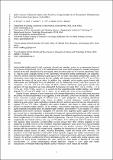Sulfur sources of buckshot pyrite in the Auriferous Conglomerates of the Mesoarchean Witwatersrand and Ventersdorp Supergroups, South Africa
Author(s)
Guy, B. M.; Gutzmer, J.; Beukes, N. J.; Ono, Shuhei; Lin, Ying
DownloadOno EAPS Guy 2014 article and figures.pdf (3.102Mb)
OPEN_ACCESS_POLICY
Open Access Policy
Creative Commons Attribution-Noncommercial-Share Alike
Alternative title
Sulfur sources of sedimentary “buckshot” pyrite in the Auriferous Conglomerates of the Mesoarchean Witwatersrand and Ventersdorp Supergroups, Kaapvaal Craton, South Africa
Terms of use
Metadata
Show full item recordAbstract
arge rounded pyrite grains (>1 mm), commonly referred to as “buckshot” pyrite grains, are a characteristic feature of the auriferous conglomerates (reefs) in the Witwatersrand and Ventersdorp supergroups, Kaapvaal Craton, South Africa. Detailed petrographic analyses of the reefs indicated that the vast majority of the buckshot pyrite grains are of reworked sedimentary origin, i.e., that the pyrite grains originally formed in the sedimentary environment during sedimentation and diagenesis. Forty-one of these reworked sedimentary pyrite grains from the Main, Vaal, Basal, Kalkoenkrans, Beatrix, and Ventersdorp Contact reefs were analyzed for their multiple sulfur isotope compositions (δ[superscript 34]S, Δ[superscript 33]S, and Δ[superscript 36]S) to determine the source of the pyrite sulfur. In addition, five epigenetic pyrite samples (pyrite formed after sedimentation and lithification) from the Middelvlei and the Ventersdorp Contact reefs were measured for comparison. The δ[superscript 34]S, Δ[superscript 33]S, and Δ[superscript 36]S values of all 41 reworked sedimentary pyrite grains indicate clear signatures of mass-dependent and mass-independent fractionation and range from −6.8 to +13.8 ‰, −1.7 to +1.7 ‰, and −3.9 to +0.9 ‰, respectively. In contrast, the five epigenetic pyrite samples display a very limited range of δ[superscript 34]S, Δ[superscript 33]S, and Δ[superscript 36]S values (+0.7 to +4.0 ‰, −0.3 to +0.0 ‰. and −0.3 to +0.1 ‰, respectively). Despite the clear signatures of mass-independent sulfur isotope fractionation, very few data points plot along the primary Archean photochemical array suggesting a weak photolytic control over the data set. Instead, other factors command a greater degree of influence such as pyrite paragenesis, the prevailing depositional environment, and non-photolytic sulfur sources. In relation to pyrite paragenesis, reworked syngenetic sedimentary pyrite grains (pyrite originally precipitated along the sediment-water interface) are characterized by negative δ[superscript 34]S and Δ[superscript 33]S values, suggesting open system conditions with respect to sulfate supply and the presence of microbial sulfate reducers. On the contrary, most reworked diagenetic sedimentary pyrite grains (pyrite originally precipitated below the sediment-water interface) show positive δ[superscript 34]S and negative Δ[superscript 33]S values, suggesting closed system conditions. Negligible Δ[superscript 33]S anomalies from epigenetic pyrite suggest that the sulfur was sourced from a mass-dependent or isotopically homogenous metamorphic/hydrothermal fluid. Contrasting sulfur isotope compositions were also observed from different depositional environments, namely fluvial conglomerates and marine-modified fluvial conglomerates. The bulk of the pyrite grains from fluvial conglomerates are characterized by a wide range of δ[superscript 34]S values (−6.2 to +4.8 ‰) and small Δ[superscript 33]S values (±0.3 ‰). This signature likely represents a crustal sulfate reservoir derived from either volcanic degassing or from weathering of sulfide minerals in the hinterland. Reworked sedimentary pyrite grains from marine-modified fluvial conglomerates share similar isotope compositions, but also produce a positive Δ[superscript 33]S/δ[superscript 34]S array that overlaps with the composition of Archean barite, suggesting the introduction of marine sulfur. These results demonstrate the presence of multiple sources of sulfur, which include atmospheric, crustal, and marine reservoirs. The prevalence of the mass-dependent crustal sulfur isotope signature in fluvial conglomerates suggests that sulfate concentrations were probably much higher in terrestrial settings in comparison to marine environments, which were sulfate-deficient. However, the optimum conditions for forming terrestrial sedimentary pyrite were probably not during fluvial progradation but rather during the early phases of flooding of low angle unconformities, i.e., during retrogradational fluvial deposition, coupled in some cases with marine transgressions, immediately following inflection points of maximum rate of relative sea level fall.
Date issued
2014-04Department
Massachusetts Institute of Technology. Department of Earth, Atmospheric, and Planetary SciencesJournal
Mineralium Deposita
Publisher
Springer-Verlag
Citation
Guy, B. M., S. Ono, J. Gutzmer, Y. Lin, and N. J. Beukes. “Sulfur Sources of Sedimentary ‘buckshot’ Pyrite in the Auriferous Conglomerates of the Mesoarchean Witwatersrand and Ventersdorp Supergroups, Kaapvaal Craton, South Africa.” Miner Deposita 49, no. 6 (April 9, 2014): 751–775.
Version: Author's final manuscript
ISSN
0026-4598
1432-1866